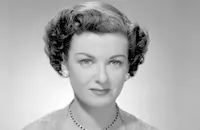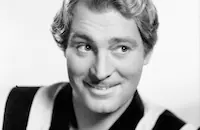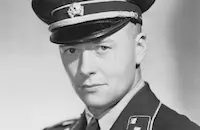I Met My Love Again

Brief Synopsis
Cast & Crew
Arthur Ripley
Joan Bennett
Henry Fonda
Louise Platt
Alan Marshall
Dame May Whitty
Film Details
Technical Specs

Synopsis
In Lynnboro Vermont, in Spring, 1925, idealistic college student Ives Towner is in love with Julie Wier, but doesn't want to get married until he amounts to something. Two years later, at Christmas, Julie has become impatient waiting and yearns for something exciting to happen. When she gets lost on the Old Mill Road during a snowstorm, she finds shelter in a cabin inhabited by New York writer Michael Shaw, who has come to work in a quiet place. Because Michael is suave and handsome, Julie becomes infatuated, as does Michael, who thinks of her as a fresh piece of paper on which to write. They elope the next day, breaking her Aunt William's heart, as well as Ives's. William wants Ives to go after Julie because she knows that the girl has made a mistake, and he does, but leaves without speaking to her when he sees her laughing happily with Michael. Michael and Julie then move to Paris, where the whirl of parties and constant drinking keeps him from writing. Tiring of their empty Bohemian existence, Julie yearns for a quieter life with their baby daughter Michael. At a party in 1930, during a mock duel, Michael is accidentally shot and killed by an artist friend. In 1937, Julie is a fashion designer, still living in Paris, but broke because she cannot get a French work permit. When she receives a letter from William enclosing news reports about Ives' research and a check for money to visit America, she decides to return home. Ives is now a biology professor and a cynical bachelor. When Julie sees her aunt again, William tells her that Ives still is in love with her, unaware that he has recently caught the eye of coed Brenda Lane, who regards herself as "Heloise" and Ives as "Abelard." When Julie meets Ives again, his disillusionment with her and love will not allow him to be warm toward her. Later, when he sees Brenda in the woods, she says her feelings for him are "almost holy," words he had spoken to Julie years before, and he takes her to a roadhouse, gets drunk and kisses her. Brenda's fresh outlook changes Ives and he calls Julie and asks her to go to a faculty dance, the first one he has ever attended. Meanwhile, Brenda goes to his house and learns from his mother where he is and decides to go to the dance herself. Seeing Julie and Ives dancing, she becomes jealous and throws a glass of champagne in Julie's face, after which Julie runs out into the rain. Ives follows her and they admit that they still love each other, then rush home to tell Aunt William that they plan to marry that night. William is ecstatic, but little Michael overhears them and makes a scene because she thinks that Ives doesn't live up to the beautiful image of her father that Julie created. At the same time, Ives' mother and sister Carol arrive to stop the wedding because Mrs. Towner thinks that Brenda, whose father is a trustee, would be a better influence on her son. After they leave, Budge Williams, a student in love with Brenda, shows up and says that Brenda tried to kill herself over Ives. Julie tells Ives that she put them on the wrong road ten years ago and they cannot go back, then, when Ives tries to convince her otherwise, she suddenly bolts and wildly drives Budge's car, with Brenda in the back seat, to the Old Mill Road. During the ride a frightened Brenda admits that the suicide attempt was a ploy to make Ives feel bad. Finally, Julie and Ives are married, while William makes little Michael realize that Ives is a good man and should be her new father.

Cast

Joan Bennett

Henry Fonda
Louise Platt

Alan Marshall

Dame May Whitty

Alan Baxter
Dorothy Stickney

Tim Holt
Florence Lake
Elise Cavanna
Genee Hall
Crew
Stanley Cooley
David Hertz
Otho Lovering
Edward Mann
Russell Matthews
Hal Mohr
Rox Rommell
Helen Taylor
Alexander Toluboff
Leonid Vasian
Walter Wanger

Film Details
Technical Specs

Articles
I Met My Love Again
The film was produced by Walter Wanger Productions and was released by United Artists. Production began in the summer of 1937 in Hollywood, with UCLA Professor Herbert R. Morgan serving as a technical advisor to Henry Fonda's college classroom scenes. The company went on location to the Franklin Canyon Reservoir in the Santa Monica Mountains for exterior shots.
David Hertz adapted Allene Corliss' book for the screen, and three directors were credited on the film: Joshua Logan, Arthur Ripley and George Cukor. Logan had been brought to Hollywood by David O. Selznick as a dialogue director in 1936. Shortly after I Met My Love Again, he would return to New York and the Broadway stage. I Met My Love Again gave Logan a chance to be reunited with his old friend Henry Fonda, who he had known at Princeton, where he had created The University Players theater troupe, whose members also included James Stewart and Margaret Sullavan.
I Met My Love Again had its world premiere in Philadelphia on January 14, 1938. Budgeted at $428,000, it only earned $416,687 at the box office, leaving it over $64,000 in the red. Despite the box office deficit, Fonda and Bennett would reprise their roles on The Lux Radio Theater on May 30, 1938. For Joan Bennett, I Met My Love Again had a happier ending - she married the film's producer, Walter Wanger, in 1940.
SOURCES:
Bernstein, Matthew Walter Wanger: Hollywood Independent
"Hathaway Claims New Player." The Age 17 Dec 1938
"I Met My Love Again." The Sydney Morning Herald 7 Jul 38
The Internet Movie Database
"Around and About in Hollywood." The Los Angeles Times 8 Jul 37
McKinney, Devin The Man Who Saw a Ghost: The Life and Work of Henry Fonda
Sweeney, Kevin Henry Fonda: A Bio-Bibliography
"Talking Movie of the Week." Life 11 Oct 37

I Met My Love Again
Louise Platt, 1915-2003
She was born on August 3, 1915 in Stanford, Connecticut. Her father was a Navy doctor who relocated to Annapolis, Maryland when she was a toddler. An early interest in school dramatics eventually led her to theater as a profession, and she made her Broadway debut in 1936 in a Philip Barry play, Spring Dance.
Platt made the move to Hollywood two years later, and although her film career was short (1938-1942), her keen intelligence in a variety of parts left a very pleasant impression on the silver screen. She was an effective romantic lead opposite Henry Fonda in Henry Hathaway's Spawn of the North (1938); held her own in a star-studded cast that included John Wayne, Thomas Mitchell and Claire Trevor, in John Ford's brilliant Stagecoach (1939); displayed a deft comic touch alongside Melvyn Douglas in Leslie Fenton's minor mystery gem Tell No Tales (1939); led a battleship into war (really) in Richard Wallace's cultish adventure yarn Captain Caution (1940); and showed some striking allure as a femme fatale in Jack Hively's noirish thriller Street of Chance (1942).
Despite her uniformly excellent performances in these films, Platt returned to Broadway, where her star shone brightly in the '40s when she landed the leads in such plays as Johnny Belinda and Anne of a Thousand Days. Platt would make some guest appearances on a few television shows in the '50s, including Alfred Hitchcock Presents, The Naked City, and a regular role in the popular soap opera The Guiding Light, before returning to the stage for the remainder of her career. She is survived by two daughters and several grandchildren.
by Michael T. Toole
Louise Platt, 1915-2003
Quotes
Trivia
the cinematographer appears as a college boy at the beginning of the movie.
Notes
The working titles of the film were Summer Lightning, and Carelessly We Love. This was theatrical director and producer Joshua Logan's first film as a director. He did not direct another picture until Picnic (1955). According to copyright records, portions of the picture were filmed in the Franklyn Canyon area of Los Angeles and the novel was serialized in Hearst's International-Cosmopolitan. A news item in Hollywood Reporter prior to the film's production noted that Brian Aherne would appear in the film. Available contemporary information cannot confirm whether Aherne was to play the role given to Henry Fonda or Alan Marhsall. A news item in Hollywood Reporter noted that this film marked actress Louise Platt's motion picture debut. Fonda and Joan Bennett recreated their roles for a Lux Radio Theatre broadcast on May 30, 1938. According to modern sources, George Cukor directed a few scenes in the picture.















